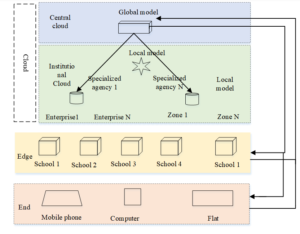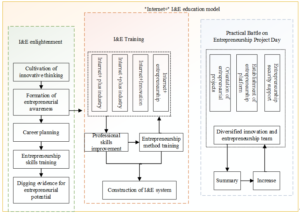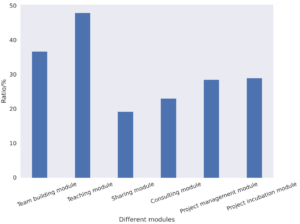This study explores the integration of “Internet+” into university education to enhance students’ learning, innovation, and entrepreneurship (I&E) skills. By updating educational concepts and methods, we aim to establish a comprehensive I&E framework that includes mindset development, knowledge acquisition, skill enhancement, and team support. Practical training and network learning communities are emphasized to provide global platforms for skill improvement and project incubation. Through a case study, we analyze the development and effectiveness of an I&E education platform, highlighting the importance of targeted demand surveys and data analysis. Our findings demonstrate the significance of aligning talent training with industry needs, fostering creativity, and promoting entrepreneurial success through collaborative school-enterprise initiatives.
The I&E courses taken by students are extremely thorough. We need to innovate and be more involved in college students’ I&E learning process if we want to increase their effectiveness [1,2]. For college students’ I&E education projects, we should place a high value on developing a “Internet+” learning model in the context of the successful integration of “Internet+” and diverse industries. We can only teach I&E education courses to students more successfully in this manner [3]. Based on the overall state of student I&E education projects, it can be said that while “Internet+” application has garnered some attention and produced some outcomes, it still complies with higher standards and requirements. There are still numerous flaws in the I&E course teaching approach for college students, which restricts their ability to learn [4].
The successful fusion of “Internet+” with I&E education project instruction from college students will enhance the learning resources and optimize the teaching system even more [5]. Forming a better functioning mechanism and management model is one of the main goals of this procedure, particularly the construction of the network platform for the I&E training class for college students. The “Internet+” application can make significant progress in “practical education” by teaching I&E education courses to college students, as it is also practical to teach these courses to students [6,7].
“Internet+” refers to linking the Internet to many businesses; in this new setting, it gave students access to a cutting-edge technological platform that is not possible through traditional or in-depth learning [7]. Students from important colleges and local institutions start from scratch in the “Internet+” I&E activities. They collaborate to meet new challenges, exchange business prospects, and help develop and embody personal advantages. However, according to the Internet, students must constantly develop their inventive awareness and entrepreneurial thinking in order to succeed in developing sectors. They must also raise their professional level and application ability [8-11].
The contribution of this article is as follows:
Proposed a comprehensive training model of I&E education based on the perspective of “Internet plus”, and systematically improved the concept, teaching methods and learning ideas of university education by integrating I&E culture, technology, learning content and students themselves.
Through the investigation and analysis of students’ participation in I&E projects, the participation, main problems, and needs of students in different grades in I&E activities were revealed, providing data support for improving I&E education.
Detailed the development environment and technical requirements of the I&E education platform, and proposed effective platform functional modules tailored to student needs, including team formation, teaching, experience sharing, competition, information, and incubation functions.
Early in the study, as shown in Figure 1, the following teaching model was developed through the actual teaching process using the design concepts of connectionism and constructivist learning theory, as well as the “learning+project” design idea.
This teaching approach integrates information resource sharing and Q&A exchange interaction in the process of implementing the two links, which are online learning and project practice. Test and diagnosis, online learning and evaluation, project practice, and incubation are all steps in the I&E learning process.

FL solves the issues of traditional machine learning’s centralized dependence and data privacy protection while introducing more organizations or institutions to join the data and enhance the model overall. FL achieves “data available but not visible” and “data not out” through iterative training operations. Overall, the model’s quality can be raised. When data owners have more overlapping data features and less overlapping samples, the horizontal FL is applicable; when data owners have more overlapping samples and less overlapping data features, the vertical FL is applicable; and when data owners have few overlapping data features and their samples, as in Figure 2, the federal migration learning is applicable.

This study creates a three-layer logical architecture of student I&E data sharing and security protection technology (see Figure 3 on the following page) based on the aforementioned analysis of the fit between student I&E data sharing, security protection challenges, and FL technology. In light of the transmission bandwidth issue between the vast amount of unstructured data produced by the school and the region, the equipment deployed in the school can be used to complete part of the model training computation tasks, after which the model parameters can be exchanged with the trusted central cloud and the institutional cloud, which together make up the technical logic system of this study. The edge, on the other hand, refers to edge computing.

Actually, the volumes of I&E learning data collected by Enterprise A (with in-school data), Enterprise B (with home data), and Science and Technology Museum (with independent exploration data) vary, and their student samples in different regions do not intersect, or even in the same region, there is little to no intersection. Nonetheless, there is a significant amount of feature dimension overlap among the data representing students’ I&E learning competence because the data are essentially consistent in terms of feature dimensions. As a result, as shown in Figure 4, training data in this instance must come from all student samples from Enterprise A, Enterprise B, and the Science and Technology Museum that have overlapping student I&E learning literacy data features.

Let
Therefore, in this case, we need to use the overlapping student sample data from schools, education technology enterprises and education authorities as training data, and extend the data feature dimensions to all the feature fields covered in the tripartite database, and then carry out the construction of the student physical fitness and health literacy evaluation model based on longitudinal FL, as in Figure 5.
Let{D learn}

To improve students’ learning motivation, stimulate innovation consciousness, explore entrepreneurial potential, and cultivate students’ I&E practical ability as the main line, the I&E education curriculum is divided into three stages: I&E initiation course, I&E practical training course, and entrepreneurship project practical course. The first classroom education is integrated into the second classroom education, and the second classroom education is an effective supplement to the first classroom education. The course teaching arrangement emphasizes the integration of course knowledge, innovates course teaching methods and teaching methods, encourages students’ I&E learning, collaborative learning and ability demonstration, guides students to build diversified network learning communities and diversified I&E teams, integrates school-local cooperation into course teaching, and actively cultivates and motivates students. The specific I&E course education model is in Figure 6.
Cultivating students’ learning skills and I&E ability is an important content of university education under the perspective of “Internet+”. We focus on guiding students to combine I&E culture, technology, learning content and themselves, and realize a real learning-oriented talent cultivation path by updating concepts, teaching methods and learning ideas according to the cultivation program of forming I&E mindset, constructing knowledge system, improving I&E skills and supporting I&E team. In the I&E practical training to strengthen students’ professional skills improvement and entrepreneurial methods, encourage and help students to build a diversified network learning community, through which the network learning community can enable students to form virtual communities globally, providing a convenient platform for college students to improve their abilities and incubate I&E projects.

This experiment starts with a specific I&E project, from the concept of product design, a comprehensive analysis and summary of user requirements research, system requirements, functional requirements, performance requirements, etc.
Analysis of students’ participation in I&E projects and competitions in different grades

From the data chart in Figure 7, we can see that in the first year and the second year, I&E projects or competitions are rarely participated in, and the demand for participation is strong. The proportion of non-participation and unwillingness to participate is 88% and 64% respectively, increasing gradually from the first year to the fourth year. This is mainly due to the gradual opening of I&E student courses and the active promotion of competitions such as Internet+ I&E student courses and Challenge Cup. There are still 4-9% of students who are not interested in the projects and competitions of I&E students, so it is worth considering how to cultivate these I&E students.

Through data analysis of Figure 8, the problems with a combined score of more than 30% mainly lie in one is wanting to research a problem but lacking professional knowledge (57%), two is not being able to find a mentor (36%), and three is having no creativity and not being able to find a suitable teammate (34%). This requires us to devote more attention to the curriculum construction, teacher and expert pool construction, creative case and resource library construction, team formation and project management when designing the I&E education platform.

Through the analysis of the Figure 9, it can be verified again that in the process of platform design and development, it should focus on the construction efforts of teaching module, teaming module, project incubation and management module.
As a technical college students’ entrepreneurial team, the Studio has combined its technical advantages and campus network environment to analyze the requirements of platform development environment. The development environment of the online teaching platform for I&E education is in Table 1.
| Project | Implementation |
| System platform | Windows server |
| Application program | Program running environment: Apache |
| – | Program development language: PHP |
| – | Program development framework: Think PHP |
| – | Program style framework: Bootstrap |
| Database | My SQL |
To sum up, the current “Internet+” technology has brought opportunities and challenges to I&E students. Only colleges and students can seize the opportunity, combine reality, constantly improve the “Internet+ era”, and combine reality. Constantly improve the I&E education mechanism in the “Internet+” era to attract more college students to participate. Only by building high-quality I&E education can we fully stimulate students’ entrepreneurial enthusiasm and enthusiasm, provide positive and correct leadership. From the perspective of “Internet+”, the teaching reform of information technology courses for college students is an inevitable choice to adapt to the development of the times.
The authors declared that they have no conflicts of interest regarding this work.
Zhou, J., Zhang, D., Ren, W. and Zhang, W., 2022. Auto color correction of underwater images utilizing depth information. IEEE Geoscience and Remote Sensing Letters, 19, pp.1-5.
1970-2025 CP (Manitoba, Canada) unless otherwise stated.